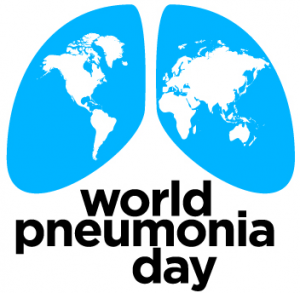By Chisom Obi
Sometime in 2007 as a National Youth Service Corp (NYSC) member, I recall witnessing my neighbour struggle to revive their 14-month old baby boy whose chest was heaving as he struggled frantically for breath. Little Abubakar was later diagnosed with pneumonia, but sadly died before proper treatment could come his way. Unfortunately, Abubakar’s case is only one of the thousand of cases recorded yearly in Nigeria. Besides malaria, pneumonia burdens Nigeria at a significant rate. It is the second leading cause of child deaths.
Although pneumonia is preventable and treatable, an alarming 6.7 million cases occur every year in Nigeria. It is estimated that 750,000 children under the age of five die annually in Nigeria. Of these, about 127,000 died of pneumonia alone, accounting for 17% (including neonatal) of all under-five deaths in Nigeria. This means that for every hour you spend watching Channels TV news, Telemundo episode or a 60mins Sports highlight, 14 children under the age of five will die of pneumonia. Sadly, many of these cases and deaths are due to lack of access to interventions to both prevent and treat pneumonia.
Nigeria has introduced interventions to strengthen efforts towards pneumonia control. One example is the local production of dispersible amoxicillin tablets in the country, which is currently the first line of treatment for community-acquired pneumonia. Another is the phased introduction of the pneumococcal conjugate vaccine (PCV) (a highly effective vaccine against the commonest types of pneumococcal diseases) into the routine immunization system in December 2014. It is expected that PCV will be fully scaled to the whole country by early 2016. Furthermore, the country has commenced the process of introducing the integrated community case management for malaria, pneumonia and diarrheal diseases.
However, gaps still remain in the general knowledge of, and in the diagnosis of pneumonia especially at the lower level of health care service delivery (primary health care centers and rural communities). There is also poor access to technologies such as X-ray machines and pulse-oximeters for diagnosis, and oxygen therapies for treatment.
We now have an opportunity to create visibility to the multifaceted pneumonia response in the country, for a more unified and integrated pneumonia control agenda. The WHO and UNICEF Global Action Plan for the Prevention and Control of Pneumonia and Diarrhea (GAPPD) calls for an integrated approach to pneumonia and diarrhea control with interventions to protect, prevent, and treat the diseases. The GAPPD also sets out coverage targets for key interventions to end preventable child deaths from pneumonia and diarrhea by 2025. Every year, progress of the 15 countries with the highest-burden of child mortality from pneumonia and diarrhea are assessed through GAPPD scores, developed by the International Vaccine Access Center (IVAC) of the Johns Hopkins Bloomberg School of Public Health. The GAPPD scores are derived from an average of countries’ coverage levels across key GAPPD indicators for which data are available. Based on the recent scoring, Nigeria ranked 2nd in position with GAPPD pneumonia intervention score of 39% in 2015. Although there was a 2% gain in Nigeria’s GAPPD pneumonia intervention score from 2014 to 2015, this gain is insignificant. A recent national and zonal analysis on the progress of pneumonia interventions in Nigeria revealed that overall, the country did not meet any of the GAPPD target on the recommended nine key interventions:
- Protect interventions: Exclusive breastfeeding for a child’s first six months and adequate complementary feeding;
- Prevent interventions: Coverage rates for the third dose of pentavalent vaccine (penta3), measles vaccine; HIV prevention in children; access to improved water sources, and access to improved sanitation facility; and
- Treat interventions: Access to an appropriate health care provider and antibiotic treatment for children with suspected pneumonia.
This explains the country’s lack of progress in reducing pneumonia deaths over time, when compared to other causes of child mortality such as malaria and measles, which have reduced by 34% and 97%, respectively from the year 2000 to 2013.
It is also worth noting that current interventions against pneumonia could save more than 500,000 lives by 2020 if the national coverage target of 87% for vaccinations (DPT3/Penta3, Measles, PCV3), and 80% for exclusive breastfeeding and antibiotics are met. Beyond lives that could be saved, achieving 90% coverage of vaccines against the common childhood infections caused by Haemophilus influenzae type b (Hib), pneumococcus, rotavirus, measles and pertussis (between 2011 and 2020) would avert $17 billion dollars in treatment costs and productivity losses in Nigeria. (Source: http://www.jhsph.edu/research/centers-and-institutes/ivac/projects/nigeria/IVAC_infographic-Breaking-Down-Barriers-to-Immunization-Coverage.pdf)
As we mark this World Pneumonia Day, an annual event that occurs every November 12, let us be mindful that while raising awareness about pneumonia is necessary, generating action plan(s) to help combat pneumonia and promote targeted interventions to reach the communities and children that need them the most is of upmost importance.
Targeted interventions to protect, prevent, and treat pneumonia
- Children should be protected from pneumonia and other diseases by boosting their natural defenses through adequate nutrition including exclusive breastfeeding and complementary feeding.
- Vaccination against Hib, pertussis (whooping cough), measles and pneumococcus; preventing HIV transmission from mother to child (PMTCT); improving access to clean water source and sanitation facility; and eliminating household air pollution especially smoke from unsafe cook stoves can help prevent pneumonia as well as reduce the incidence of other diseases that increase pneumonia risk and severity in children.
- Children who become ill with pneumonia need prompt diagnosis and appropriate treatment with antibiotics to prevent disease progression. In addition, effective, integrated case management strategies and improving care-seeking behaviour and referral ensure that children receive proper and timely treatment for pneumonia in the community, health centres and hospital.
It is therefore imperative to introduce and scale up efforts that will improve access to proven interventions to fight this preventable and treatable disease that contributes significantly to under-five deaths in the country. With 17% of the Nigerian population composed of under-five children, the impact of pneumonia affects almost every household.
“Every Nigerian child deserves the chance to celebrate his/her fifth birthday no matter what circumstances he/she is born into”.
For more information on pneumonia facts and figures in Nigeria, visit www.directconsultingng.com.
Chisom Obi is a Research Consultant with Direct Consulting and Logistics, consulting for International Vaccine Access Centre (IVAC) Nigeria.



